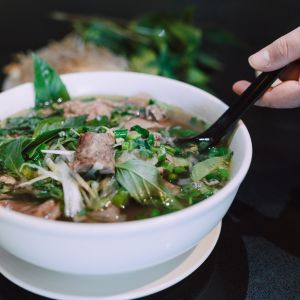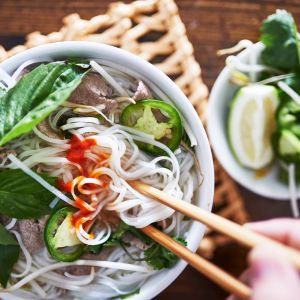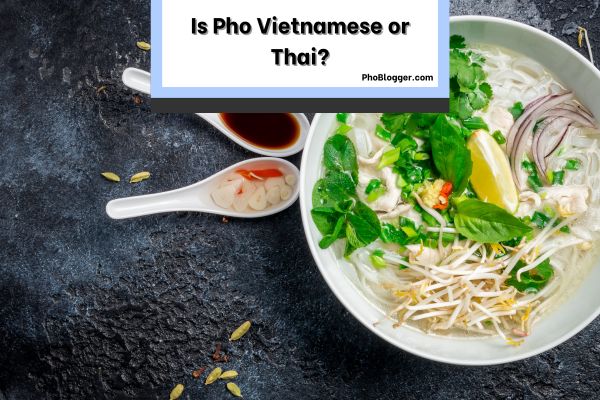Is pho Vietnamese or Thai? Where did pho originate from? Here’s everything you need to know about the origin of pho. Pho is a dish that has gained widespread popularity all around the world, and its distinct flavors have left many people curious about its origins.
Is pho Vietnamese or Thai? The short answer is: Pho is a traditional Vietnamese dish. But to fully understand the roots of Pho and its cultural significance, we need to delve into the history, preparation, and variations of this beloved noodle soup.
Before you scroll further down this article, “Is Pho Vietnamese or Thai,” you can check out these other pho-related content from our team at PhoBlogger.com:
Historical Origins of Pho

The origins of Pho are deeply ingrained in Vietnam’s history. It’s believed to have originated in the early 20th century in northern Vietnam, near Hanoi. The word “Pho” itself likely comes from “feu,” a French word meaning fire, pointing to a French influence during the colonial period.
However, despite potential foreign influences, Pho is uniquely Vietnamese, a testament to the nation’s culinary ingenuity.
More Pho-Related Guides: Does Pho Have Peanuts and What’s the Difference Between Pho vs. Udon?
Key Characteristics of Vietnamese Pho
Vietnamese Pho is characterized by its flavorful broth, typically made from beef bones that are simmered for several hours with spices such as star anise, cinnamon, and cloves. Rice noodles, known as bánh phở, are a staple ingredient, as are thin slices of beef or chicken.
The dish is typically garnished with fresh herbs like cilantro, green onions, and basil, and served with lime wedges, bean sprouts, and chili peppers on the side. There are two main types of Pho in Vietnam: Pho Bac and Pho Nam, referring to northern and southern styles, respectively.
Pho Bac, from the Hanoi region, typically has a clear, subtly flavored broth and fewer toppings. Pho Nam, which is more common in Ho Chi Minh City, often features a sweeter, more robust broth and a wider variety of garnishes.
More Pho-Related Guides: Does Pho Have Eggs as an Ingredient and Does Pho Have Sesame?
Pho vs. Thai Noodle Soups
While Pho is a traditional Vietnamese dish, it’s worth noting that many Southeast Asian cuisines have their own variations of noodle soups. Thai cuisine, for instance, is known for dishes like Tom Yum, a spicy and sour soup, and Khao Soi, a creamy curry noodle soup.
However, these dishes are distinct from Pho in terms of ingredients, preparation, and flavor profiles. One popular Thai noodle soup that sometimes gets compared to Pho is Guay Tiew, also known as Thai Boat Noodle Soup.
Like Pho, Guay Tiew can be made with various types of meat and uses rice noodles. However, its broth is usually darker and richer, often flavored with dark soy sauce, sugar, and sometimes even pig’s or cow’s blood. The soup also commonly includes bean sprouts, morning glory, and Thai basil, but the overall taste is quite different from Pho.
More Pho-Related Guides: How Long is Pho Good For and Is Pho Broth Vegetarian?
The Global Influence of Pho
Pho has now been adopted and adapted by many other cultures, leading to various interpretations worldwide. For example, in the US, Pho restaurants often offer a wide array of toppings and broth flavors, catering to diverse palates and dietary needs.
Despite these global variations, the heart of Pho remains Vietnamese. It continues to be a significant part of Vietnam’s culinary identity and a cherished comfort food for many. Whether enjoyed in a street-side stall in Hanoi, a bustling restaurant in Ho Chi Minh City, or a trendy eatery in New York City, Pho carries with it a taste of Vietnamese tradition and culture.
While Pho shares similarities with certain Thai noodle soups and has been embraced by various global cuisines, it is distinctly Vietnamese in its origins and core characteristics. Its unique combination of flavors and ingredients reflects the culinary heritage of Vietnam, making Pho not just a delicious dish but also a cultural marker of Vietnamese identity.
The rich history and cultural significance of Pho make it a beloved and iconic dish that represents the flavors and traditions of Vietnam. As Pho continues to gain popularity worldwide, it’s important to respect and appreciate its origins. Vietnamese cuisine is a vibrant and diverse culinary tradition that extends beyond just Pho, with countless other dishes and flavors to explore.
Whether you’re enjoying a steaming bowl of Pho in Vietnam or savoring it in a Vietnamese restaurant in another part of the world, you’re not just experiencing a delicious meal, but also a connection to the rich tapestry of Vietnamese culture.
More Pho-Related Guides: What is Pho Made Of and Is Pho Dairy Free?
Frequently Asked Questions
Is Pho gluten-free?
Traditional Pho made with rice noodles is naturally gluten-free. However, some commercial Pho broths and sauces may contain gluten or additives, so it’s important to check the ingredients or ask the restaurant about their preparation methods if you have gluten sensitivities or allergies.
Can Pho be vegetarian or vegan?
Yes, it is possible to enjoy vegetarian or vegan versions of Pho. Instead of using beef or chicken broth, vegetable broth or mushroom broth can be used as a flavorful base. Tofu, seitan, or a variety of vegetables can be added to create a satisfying vegetarian or vegan Pho.
Are there different regional variations of Pho in Vietnam?
Yes, Pho can vary slightly in different regions of Vietnam. Pho Bac, from the northern region, is known for its clear broth and simpler garnishes. Pho Nam, from the southern region, tends to have a sweeter and more aromatic broth with a wider variety of toppings. These regional variations add to the diversity and charm of Pho throughout Vietnam.
Can I customize my Pho toppings?
Absolutely! One of the joys of enjoying Pho is the ability to customize it to your liking. Most Pho restaurants provide a variety of garnishes and condiments on the side, such as bean sprouts, lime wedges, Thai basil, chili peppers, and hoisin sauce. Feel free to add or omit toppings based on your preferences.
Can I make Pho at home?
Yes, making Pho at home is possible, although it requires time and effort. The key is to prepare a flavorful broth by simmering bones, spices, and aromatics for several hours. Rice noodles can be cooked separately, and various toppings can be added according to your preference. There are many recipes and variations available online to guide you through the process.
Conclusion For “Is Pho Vietnamese or Thai”

Pho is a traditional Vietnamese dish that has captured the hearts and taste buds of people around the world. Its distinct flavors, aromatic broth, and comforting ingredients make it a culinary delight.
Whether you enjoy it in a bustling Vietnamese market or a local restaurant, Pho offers a glimpse into the rich cultural heritage of Vietnam. So, savor each spoonful, embrace the warmth of the broth, and appreciate the history and flavors that make Pho a truly special and beloved dish.
If you find this article, “Is Pho Vietnamese or Thai,” helpful/informative, you can check out these other pho-related content from our team:
You can learn more about the origin of this popular noodle dish by watching “The History of Pho” from Food For Thought down below:

